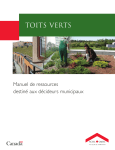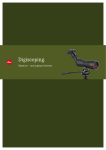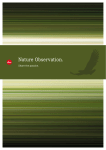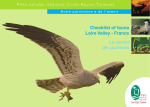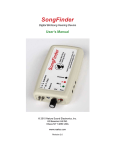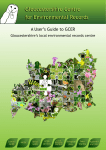Download Template User Guide to Enhance Biodiversity and Promote Ecology
Transcript
Template User Guide to Enhance Biodiversity and Promote Ecology in Sustainable Schools GOLD * This document should be used as a guide for meeting the criteria set out within Section 7 (Sustainability) of the Scottish Building Standards Non-Domestic Technical Handbook Overview How does this guide work? This guide sets out a step-by-step process for enhancement of biodiversity and promotion of ecology in the external grounds of sustainable schools, from early planning of the school build, the design and construction and achieving the Silver or Gold sustainability award (Building Standards Labelling System introduced as part of Section 7 (Sustainability) Non-Domestic Technical Handbook, see Page 3), through to operation and enjoyment of the school by the school community. The guide aims to provide a process for the developer to prepare an ecological report and create a Bespoke Biodiversity User Guide (Step 1 and 2) required through the Silver and Gold sustainability level, and provide practical advice and supporting information for schools to continue to develop their outdoor space for biodiversity (Step 3, 4 and 5). The six steps of this guide are shown in Figure 1. Step 1 Ecological Report including Site Review Step 2 Bespoke Biodiversity User Guide Step 6 Step 3 Reviewing and Reporting Progress School Vision and Objectives Step 5 Step 4 Measuring and Monitoring Progress Action to Enhance Biodiversity Figure 1 – Six Stage Overview of the User Guide 1 Why Biodiversity? Biodiversity, or "biological diversity" is the variety of all living things on our planet, from wildflowers and insects to mammals, reptiles, trees and birds. It applies to the habitats in which these living things are to be found - woodlands, upland moorland, meadows and wetlands, as well as man-made places such as fields, parks and canals. All of this forms the life support system for our planet. Biodiversity serves us in many ways through what is known as ‘ecosystem services’, providing; • • • • • food, medicine and other materials; a clean and healthy environment; colour and beauty to our surroundings; healthy living and wellbeing; and an important part of our art, culture and tradition. Biodiversity is a measure of sustainable development helping us to gauge how we meet our needs today without impacting on the quality of life for our children and the needs of future generations. 2 Building Standards – Sustainability Labelling Section 7 (Sustainability) Scottish Building Standards Non-Domestic Guidance Sustainability Aspect: Biodiversity Award Level: Bronze Bronze Sustainability Award Level does not include any requirements for biodiversity Silver (a) Allotment in an area of at least 5% of the building footprint, containing enclosure for storage/maintenance (6m2), 2 composting bins (160 litres), 1 water butt (with a minimum capacity of 200 litres) for outdoor use, and a dedicated green house space for the purpose of growing fruit, vegetables and herbaceous plants (6m2). (b) Natural Boundary: 25% length of the site boundary that is not part of the building elevation to be defined/augmented by planting or natural features. (c) Natural habitat or native woodland area (15% of the overall site area). (d) A bespoke biodiversity strategy document specific to the school, for use by pupils, teachers and the wider community. Gold (a) Allotment: provided as for Silver. (b) Natural Boundary: 50% length of the site boundary that is not part of the building elevation to be defined/augmented by planting or natural features (e.g. attenuation ponds, woodland, natural habitats and allotments). (c) Natural habitat or native woodland area (30% of the overall site area). (d) Biodiversity strategy document: provided as for Silver. GOLD 3 Step 1 – Ecological Report Preparation of the Ecological Report Step 1 of preparing the guide will generally take place during the planning application stage for the school, where decisions are made as to which level for sustainability the school wishes to aspire to (Silver or Gold). It is a key stage since it will provide the information (ecological report and assigned areas of land for biodiversity) which can inform the development of the Schools’ external spaces and bespoke ‘Biodiversity User Guide’ (Step 2). The guide will enable the school users and community to develop features such as allotments, orchards, naturally defined perimeters, natural habitats and woodlands, sustainable urban drainage systems and green roofs or living walls. The ecological report should include (but not be restricted to): • • • • • site location; soil conditions; flora and fauna typical of the site; geological features; and any features which are to be protected (e.g. trees, shrubs, geological features, wetland areas). An example process of collecting the key information to be used to develop the bespoke Biodiversity User Guide is illustrated in Figure 2. Site Selection and Feasibility Studies Ecological Report Design Development Assigned Areas of Land for Biodiversity Planning Permission, Building Warrant Application and Construction Develop School Specific/Bespoke Biodiversity User Guide Completion. Silver or Gold Sustainability Award Handover of Building to School Community Deliver Biodiversity Improvements Figure 2 – Preparing the School for Biodiversity 4 Step 2 – Bespoke Biodiversity User Guide Developing the Bespoke Biodiversity User Guide Example Biodiversity Vision The Silver or Gold levels for sustainability require the developer of the school to use key information in Step 1 (the ecological report and assigned areas of land) to produce a bespoke ‘Biodiversity User Guide’ specific to the School. This Guide is to be completed before building completion (see Figure 2). The guide should: “A biodiversity rich external environment which provides a sustainable resource for recreation and learning, and promotes an inclusive and engaging environment for the school and the wider community” • set the scene for the school site using the key findings of the ecological report; • include a biodiversity vision, which reflects the level of biodiversity the new school build will aim for (Silver or Gold); See ‘Our School Biodiversity Guide’. This guide serves as an example bespoke biodiversity user guide (of a hypothetical school) which can be used by the developer as a basis for developing their bespoke ‘Biodiversity User Guide’. • a plan of the assigned areas of land for biodiversity in the external space of the school; and • guidance and recommendations as to how the school community can take what has been provided to them by the developer to further enhance the external space of their school for biodiversity. 5 Step 3 – School Vision and Objectives Biodiversity Vision Checklist 3.1: Vision Explore the elements of biodiversity that’s important in your locality, and that the school community most values about its immediate area and environment. See your Local Biodiversity Action Plan for the habitats and species that are important to your local area. Information can be built on by taking pictures, doing your research online, and may involve visits to neighbouring habitats and important nature sites in your locality Use your bespoke Biodiversity User Guide to identify the challenges and opportunities going forward. Seek support and knowledge from local experts (i.e. Local Biodiversity Officer, Local Outdoor Learning Officer, Local Biodiversity Action Plan, Scottish Natural Heritage, Forestry Commission Scotland, RSPB, Woodland Trust, Grounds for Learning etc) (see Page 25) Envisage a future landscape around the school where enhanced biodiversity provides opportunities for learning Combine any individual visions into a collective vision for the school What is a VISION? A vision for biodiversity would have been provided to the school through the developers’ bespoke ‘Biodiversity User Guide’ (see Step 2). Revisit this vision and if required tailor it to the aspirations of the school community. Your vision should aim to create an inspirational picture of how the natural environment around the school might look. The vision should be ambitious, but not committing to the impossible, inspirational, and worth working towards, appropriate, relevant to the local school environment and based on the sustainability award (Silver or Gold level) provided at completion of construction. 6 Step 3 – School Vision and Objectives Biodiversity Objectives Checklist 3.2: Objectives Use your vision to develop a series of objectives which set out the main steps needed to deliver against the aspirations of the school for biodiversity. Break your vision down into manageable elements. Use the findings of the ecological report (see Step 1) and any further environmental information you have gathered Collectively set objectives that will deliver actions on the ground. Involve the school community in this process, your objectives must be biodiversity focused but also reflect the wants and needs of your school community. Objectives should not only aim to enhance biodiversity but also develop the outdoor space for education and play Make sure there are resources available and realistic timescales for achieving your objectives Good objectives are relevant to the vision and local circumstances, are clear, action focused, achievable and motivating. Your objectives could deliver multiple benefits, not only for enhanced biodiversity, but for enhanced teaching and play. Think about how your objectives tie in with other pieces of work taking place within the school. Example Objectives Raise awareness of the value of biodiversity and ecology within the school and wider community Increase the recreational value of the outdoor space Develop and enhance suitable habitat for species important to the local area Encourage the use of outdoor space as a teaching resource Create outdoor areas which promote a range of wildlife species including butterflies, birds and red squirrel 7 Step 4 – Actions to Enhance Biodiversity Introduction The following pages provide information sheets on how to create and maintain environmental features for enhancing biodiversity in the outdoor space of your school. Biodiversity Actions Checklist Who will be responsible? What are the skills needed to deliver and maintain it? Can the school community be involved, and can events and activities be planned to create ownership? How can the environmental feature be made relevant to your locality (i.e. to attract particular bird or insect species, or to enhance habitats important to your local environment) A combination of features can provide enhanced benefits for biodiversity, such as placing bird boxes within your woodland, or a wildflower meadow alongside your naturally defined perimeters What information and resources are needed to deliver it (making use of local experts, knowledge and advice) Timetable and resources (including maintenance calendar). Think of ways in which the school community can be involved, in particular out of term time Opportunities for funding and support Possible barriers and solutions (e.g. solutions for health and safety) How features will contribute to increased opportunities for learning and play They include: • • • • • Allotments Orchards Natural habitats or woodlands Naturally defined perimeters Sustainable Urban Drainage Systems • Green roofs or living walls • Bird boxes • Wildflower meadows For each environmental feature think about the following: 8 4.1 Allotments Checklist The Benefits • Sourcing food locally reduces food miles • Promotes a balanced healthy lifestyle • Growing organically helps the local environment and benefits your health • Appropriately designed allotments boost biodiversity (e.g. bees, insects, birds and amphibians) • Learning about biological pest control Do • Mix up your plots for variety • Plant flowers that attract bees, hover flies and other beneficial insects for pollination • Plant shrubs at the perimeter that produce berries in the autumn and winter (to attract birds) Plan what you want to achieve and design your layout accordingly e.g. size, key elements (i.e. raised beds, gardening tools, greenhouse/poly tunnels), types of growing beds, plant species, arrangement of plots, access, paths, seating areas Clear the plot of unwanted materials and debris. Aim to clear in early spring, in time for early planting and sowing. Vegetation can be buried as green manure after removing the roots of perennial weeds When clear of weeds the soil can be broken up and organic matter added by digging or rotovating, or while building raised beds. Outfit the plot with tools, compost bins and other useful items Start to create vegetable plots that have areas of biodiversity interest (e.g. flower beds or a wildflower meadow nearby to attract insects) Maintain your plots. During the summer holidays keep a task board updated, and those who come to tend the allotment during the summer can be rewarded by taking a share of produce home Case Study Look out for: • • • • • • • • Honey bees Bumble bees Hover flies Butterflies Garden birds Frogs and toads Hedgehogs Voles and shrews Rothesay School Garden Rothesay allotment is open all year round. The school successfully manages maintenance during the summer holidays by creating a rota for pupils and parents. Helpers are allowed to take home the day’s fresh produce as a reward Link: http://www.ltl.org.uk/pdf/Rothesaycase-study-final1332847577.pdf 9 4.2 Orchards Checklist The Benefits • Good option for schools with limited space as fruit trees can be trained to grow across walls and fences • Seasonal learning resource, fruit trees blossom in spring and produce fruit in late autumn • Rich in biodiversity. Orchards support a wide range of insects, bees and birds and ideal habitat to incorporate wildflowers and deadwood to further diversify the area Case Study Possil Park Concrete Garden, Glasgow A community space for growing food (including orchards) using reclaimed industrial land. Winner of the Scottish Design Award in 2011 Link: http://possilparkconcr etegarden.blogspot.co .uk/ Plan what you want to achieve e.g. size, space arrangements, type of fruit tree Choose the location (a sheltered, sunny south or southwest facing area is better for fruit development) and design the layout (include access, paths, seating areas) Clear the area of unwanted materials and debris (bramble, nettle, thistle and other weed species must be controlled by regular mowing, hand pulling or digging). Herbicides should be used sparingly Manage your grassland. For grass at the tree base maintain sward height between 5 and 15cm, to both aid growth of the fruit tree and allow access. Rough grass on the edges of the orchard can be left unmown or managed to provide a wildflower area, to attract bumblebees and insects Select and plant the trees. Bare rooted trees should be planted from December to March, when they are not in leaf, but not during periods of frost. Containerised trees can be planted at any time Maintain your orchard and watch it produce a variety of fruit whilst encouraging biodiversity Do • Choose a variety of orchard species • Incorporate wildflowers and other environmental features which attract insects. Attracting insects will help to pollinate your orchard • Plant shrubs at the perimeters. Shrubs that produce berries in the autumn and winter will attract birds to your orchard Look out for: • • • • • • • Honey bees Bumble bees Garden birds Winter visiting birds Hedgehogs Bats Mosses and lichens 10 Allotments and Orchards – Seasonal Calendar Allotments and Orchards - Seasonal Checklist January - June Month Vegetables and flowers to plant Biodiversity - What to look out for Maintenance tasks Winter visitors such as the Waxwing feeding on shrub berries Harvest any parsnips and cabbage family. Dig over beds and add manure and compost (if not done in December) . Keep bird feeding station topped up January (Mid Winter) February (Late Winter) Sow early peas (under cloches) Winter visitors such as the Fieldfare feeding on apples and berries Prune and/or shape bush and tree fruits in allotments and orchard before their buds start to burst. Continue to dig allotment beds March (Early Spring) Start to sow early vegetable crops outside (e.g. beetroot, parsnip, turnips and spinach) Garden birds feeding and preparing to breed . Look out for frogs and toads returning to the pond to spawn If beds dug over and weed free mark out ready for sowing seeds. Spread further compost April (Mid Spring) Complete sowing of vegetables (e.g. onion sets , main crop potatoes, and winter cabbages) and flower seeds (e.g. marigolds, parsley and comfrey) Tits (blue, great or coal) nesting in nest boxes near the orchard and allotments Leave self-sown annuals (e.g. marigolds and alyssum) to grow and flower among food crops where they will attract beneficial insects) . Harvest purple sprouting May (Late Spring) Sow salad (radishes, lettuce, rocket), courgettes and runner beans Watch nesting tits feeding their young. Look out for bees and hover flies starting to pollinate Hoe regularly to kill seedling weeds growing between vegetables. Treat slugs with ecofriendly slug pellets June (Early Summer) French beans and salad crops, plant out leeks Look out for butterflies, bees and an array of insects Make as much garden compost as possible from garden waste. Keep fruit bushes well watered 11 Allotments and Orchards – Seasonal Calendar Allotments and Orchards - Seasonal Checklist July - December Month Vegetables and flowers to plant What to look out for Maintenance tasks July (Mid summer) Continue with salad crops More butterflies, dragon flies, swifts and swallows flying over the garden Harvest strawberries and salad crops. Continue active weeding and thin out any vegetables too close together August (Late Summer) Sow early winter lettuces and spring cabbages Insects of all sorts with more butterflies and bees Visiting the later flowering plants Harvest raspberries, salad crops, keep on top of weeding. Water if necessary September (Early Autumn) Broad beans and spring cabbages Shrubs forming berries. Summer migrants like the swallow leaving Harvest black and red currants, French and runner beans, courgettes and more salad. Keep on top of weeding and pest control October (Mid Autumn) Plant out cabbages Birds and animals like the hedgehog feeding on windfall fruit Harvest apples, pears, plums and any other remaining fruit. Store excess fruit in a cool place. Lift and dry main crop potatoes. Continue weeding November (Late Autumn) Early peas under cloches. Plant fruit bushes such as blackcurrant Winter migrants arriving (such as fieldfares, redwings and waxwings) Shred woody and non-thorny prunings and other tough stems and use them as a mulch around shrubs, fruit trees and as cover for paths December (Early Winter) Continue to plant any fruit bushes Look out for birds visiting the bird feeding station. Tits, finches, robins and more should all pay a visit Start feeding birds when their natural food sources such as shrub berries run low 12 Natural Habitats and Native Woodlands Overview The Silver or Gold levels for sustainability require the developer of the school to create: • A natural habitat area, used to support native flora and fauna species OR • Native woodland area used for species known to attract or benefit local wildlife (see Page 3) The chosen type of natural habitat to be established in the school grounds should be appropriate to the locality of the school, and be informed by the outputs of the ecological report (see Page 4). Within your local area, important habitat may include woodland, wetland or marshy grassland, wildflower meadows or grassland (e.g. upland grassland characterised by species such as common heather, bell heather and blaeberry). Your natural habitat should reflect what is important to your locality. Your Local Biodiversity Action Plan (see your local Council’s website) or Local Biodiversity Officer are useful sources of information. The Benefits • Enhancement of habitats which are important in your locality (woodland, wetland, meadow or moorland/bog) • Help to support a variety of plant and animal species which are important to your local environment • Natural habitats, particularly established habitats, provide a range of ecosystem services. They provides us with clean air, provide shelter and shade (i.e. woodland), manage water supplies (i.e. Wetlands, SUDS) etc • Seasonal learning resource. Natural habitats change throughout the seasons and provide an opportunity to learn more about your local environment The following Information Sheets in this Guide can be referred to for tips and guidance on developing natural habitats: • Information Sheet 4.3: Native Woodland Area • Information Sheet 4.4: Naturally Defined Perimeters • Information Sheet 4.5: Sustainable Urban Drainage Systems (SUDS) • Information Sheet 4.8: Wildflower Meadow 13 4.3 Native Woodland Areas Do • Plant native tree species where possible • Incorporate other features and lower canopy habitats such as grasslands and shrubs • Plant bluebells, or in open areas native meadow flowers and grasses • Incorporate dead wood and bird boxes to attract insects and birds The Benefits Look out for: • Woodlands support a variety of species – plants, insects, birds and mammals • Provide essential ecosystem services such as oxygen production, absorb CO2, provide shelter and shade, and manage water supply • Visual amenity e.g. screening and shade, create setting and backdrop, and their height and varied composition can frame views and create corridors • Seasonal learning resource. Broadleaved species change throughout the season, producing buds in spring, seed in late autumn and drop their leaves in autumn/winter • Insects (e.g. butterflies, moths and bumble bees) • Woodland and wayside birds • Bats (older trees with cavities and flaking bark provide roosting opportunities) • Squirrels • Badgers and foxes Checklist Case Study McLean Primary School, Fife. WWF Bright Sparks Awards Taking a lead on designing and planting a mini-woodland Link: http://assets.wwf.org.uk/download s/taking_the_lead_in_designing_a nd_planting_a_mini_woodland.pdf Plan what you want to achieve. You may wish to create new woodland from saplings/whips or plan to enhance an area of existing woodland. Choose your location, you may wish to provide shelter or shade for a particular area. A suitable location for your woodland will depend on the ground conditions and the tree species which can grow well in your locality (seek local advice if necessary) Design the layout to include any access or paths and to blend in with the surrounding area. Choose your tree species - think about how high your trees might grow, and the structure of your woodland once it matures Use local advice on seed sources, planting depth, spacing, use of stakes, tree guards and mulching mats Establish any shrubs and meadow areas As your woodland matures, thin out and maintain the wooded areas to allow a semi-natural tree and shrub mix to develop 14 4.4 Naturally Defined Perimeters Look out for: The Benefits Do • Provide natural green corridors along which insect and animal species can pass • Promote biodiversity around the perimeters of species poor habitats, such as amenity grassland (i.e. habitats which support few plant or animal species) • Can provide cover for larger mammals such as badger, roe deer and squirrels • Can be used in addition to or alternate to harder features such as fences and walls to create a boundary which is visually appealing but also provides privacy, security and safety • Consider a mix of hedgerow, trees and shrubs • Plant native tree and shrub species where possible • Plant hedgerow flowers that attract insects • Plant shrubs that produce berries in the autumn and winter to attract birds • Bees (bumble and honey) and other insects • Garden birds and winter visiting birds • Hedgehogs • Bats • Badgers • Foxes • Voles and shrews Checklist Plan what you want to achieve, e.g. a perimeter around the outer boundary of the school, or a boundary to provide separation between areas Consider a combination of habitats. The biodiversity potential can be maximised by using a variety of different features (i.e. woodland, shrubs hedgerow, wildlife corridor and wildflower grassland) What habitats are present in the wider environment. Can the school grounds be enhanced to support or extend those habitats? If so choose the species you wish to plant accordingly (for instance, if acid grassland and upland habitat is important in your locality, chose species such as common heather, bell heather and blaeberry) Implement. Use a variety of native plant species where possible. Establish any woodland, hedgerows and grassy meadow areas. Thin out and maintain woodland and shrub to allow a semi-natural tree and hedgerow mix to develop Case Study Spire Infants School, Derbyshire Spire Infant School was the national winner of the School Wildlife Garden of the Year in 2010. The school has planted 80 trees around the perimeter of its school field creating a small woodland and allowing areas of grass to grow long to provide wildlife corridors. Wild flowers and shrubs have also established 15 4.5 Sustainable Urban Drainage Systems (SUDS) The Benefits • Provide natural systems for controlling surface water and reducing the risk of flooding • Help to ‘naturalise’ outdoor spaces • Provide variety for learning resources • Provide an ecological niche for aquatic species • Encourage a variety of bird, amphibian and insect species Do Look out for: • Create shallow marginal areas for plants • Create shallow areas which encourages access for education • Plant native pond plant species • Plant wet meadow flowers that attract bees, hoverflies and other insects • Plant native rush, sedge and other grass species • Try to avoid deep stagnant areas of water • Insects (e.g. dragonflies, damselflies) • Water bugs and beetles • Frogs and toads (frog spawn and tadpoles in the spring) • Newts • Waterfowl (e.g. mallard), herons and a variety of small bird species Checklist Plan what you want to achieve. The Sustainable Urban Drainage Systems (SUDS) pond is likely to be in place on completion of the school build. Think about how the design of the pond can be enhanced to support biodiversity Design the landscape around your pond to achieve complimentary habitats such as patches of open water, reed swamp, marsh, fen and meadow Access to a SUDS pond is an important consideration. SUDS provides a valuable recreation and education source, allowing users to develop their understanding of conservation and sustainable design. Swales and other open water features may include small walkways, bridges or stepping stones If perimeter fencing (for safety reasons) forms part of the design of the pond, planting can be used to enhance or as an alternative to these features and create a more visually appealing space e.g. use of bullrush and reedmace Agree any planting proposals with those who will be maintaining the SUDS pond Select the planting material that is typical of the habitat you are creating (e.g. marsh, fen, meadow) Case Study Robinswood Primary School, Gloucestershire A flood prevention scheme which aims to enhance biodiversity and encourage outdoor learning. The scheme includes a wildlife pond, shallow wetland and grassland areas, an open space for outdoor classrooms. Long term management includes a wildflower meadow and a woodland boundary Link: http://www.ginsw.org.uk/media/case% 20studies/Sustainable%20Drainage% 20System%20(Gloucestershire).pdf 16 4.6 Green Roofs and Living Walls The Benefits Do Look out for: • Provide natural surfaces for controlling surface water runoff • Help to insulate and regulate temperature in internal space and contribute to improved air quality • Attract insects and provide good feeding and nesting habitat for birds • Improves the visual appearance of your building • Good for increasing biodiversity potential for schools which have limited outdoor space • Seek specialist advice. Green roofs and living walls require proper installation and design • Plant a variety of species. Choose herbs and wildflowers which attract insects and birds • Insects • Amphibians (e.g. frogs and toads in the wetter areas) • Visiting bird life Checklist A green roof or living wall (if incorporated into the school building design) would be installed during construction of the school. Check which specialist provider is involved in its installation There would be opportunity during the installation to have some input into the variety of plant species to be used. Consider what is important in the local environment. ‘Shade’ or ‘sun’ species should be used as appropriate, and species which flower at various times of year to enhance the visual appearance of the feature. The specialist provider assigned during the construction of the school should design the wall or roof to accommodate the plants you have in mind and incorporate other features for biodiversity if required (e.g. log piles , ‘insect hotel’ and bird nest boxes) Agree design with installer and commission Maintenance is often provided by the specialist provider. There may be some tasks which can be undertaken by the teachers and pupils. Consult with your provider as appropriate Case Study King Alfred School, London A series of green roofs designed for biodiversity. Native and nonnative wild flowers were planted to help support the schools bee hive, and log piles installed to encourage invertebrates. A good example of establishing a green roof on an existing structure Link: http://livingroofs.org/201010052 31/single-articles-on-greenroofs/king-alfred-school-greenroof.html 17 4.7 Bird Boxes The Benefits • Attracting birds to your outdoor space is an easy way to observe wildlife, and to recognise seasonal changes, migration, courtship and nesting behaviour • Providing a place for birds to feed, nest and breed is important for conservation, particularly in urban environments • Birds are effective pollinators and contribute to pest control, and so help support other features of your outdoor space, such as orchards and wildflower meadows Look out for: • Rare migrants, and resident wintering species • Breeding and nesting behaviour from March to June Case Study National Nest Box Week, British Trust for Ornithology Link: http://www.bto.org/nnbw/index.htm Consider organising an Action Day, where multiple classes, and perhaps parents or members of the community can be invited to be involved in the making and siting of bird boxes. Once installed groups can be assigned responsibilities to maintain, monitor and report to the school on progress. Monitoring of the bird boxes can be done on an individual level or as part of ongoing class activity Checklist Do • Clean your bird boxes annually. It is best to wait until the autumn to do this so not to disrupt any late breeding • Repair any damaged boxes. It is important that your bird boxes are dry and secure • Observe any activity from afar using binoculars and bird identification guides • Use bird boxes appropriate for the species you hope to attract. Keep entrance holes small if you wish to attract smaller species Don’t • Disturb the bird box during the breeding bird season Plan what you want to achieve. Where will your bird boxes be located (a woodland, a perimeter boundary, etc.), how many bird boxes, and what bird species you would like to attract Source your bird boxes. Construct (this can be a fun day for various age groups) or source from a range of suppliers. The British Trust for Ornithology (BTO) recommend specific types of bird box and construction methods for various types of species. Link: http://www.bto.org/volunteersurveys/nrs/publications/bto-nestbox-guide Install. Ensure the bird boxes are sheltered from prevailing wind, rain and strong sunlight, and are at sufficient height so not to be disturbed Maintain. Bird boxes need little maintenance, but do need checked once a year for any required repairs and cleaned annually. Maintenance should take place outside of the breeding bird season 18 4.8 Wildflower Meadows The Benefits • • • Plant diversity which attracts insects and invertebrates and provides foraging habitat for birds and mammals Flowering species bring colour and interest to the outdoor space A great resource for education and play, including nature studies, species identification, art and creative learning Do • Your research on perennials and annuals and what will work best for you, and seek advice on seed mixes which are appropriate to your locality • Some maintenance. Mow only once or twice a year, weed any unwanted plants by hand, and compost any cuttings • Have fun watching colour emerge in spring and the wildlife that is attracted to your area Don’t • Don’t use weedkiller as this will kill the flowers you want to encourage. • Wildflower meadows don’t require any additional watering or feeding Checklist Choose the area for your wildflower meadow. Think about the soil type (native wildflower plants colonise better on nutrient poor soil types), amount of sunlight/shade and the hydrology of your site. Also think about access and suitability of your location for interactions with other uses of the outdoor space Source seed mix. Use a seed mix which contains species of local provenance and that support insects and birds which are typical of your locality. Soil conditions and hydrology at your chosen site also informs what seed mix is appropriate for you. Think also about colour, species, later or early flowering species Your meadow ground preparation, management and cutting regime will depend on whether you are diversifying an existing grassy area or preparing soil and starting from scratch. Royal Horticultural Society website provides some useful tips – Wildflower Meadow Establishment (Link: http://apps.rhs.org.uk/advicesearch/profile.aspx?pid=436) Case Study Braidburn Valley Park, Edinburgh With the help of the Scottish Wildlife Trust and the Scottish Executive Biodiversity Action Grant Scheme, Friends of Braidburn Valley Park and two local primary schools established a wildflower meadow in the park. The area now attracts a variety of birds, butterflies and insects, and there is evidence of natural colonisation of other wildflowers and grasses Link:http://www.braidburnvalleypar k.org.uk/wild-flower-meadow/ Look out for: • • • • • Honey bees Bumble bees Butterflies Farmland and wayside birds Small mammals 19 What to look out for Use your outdoor space as part of teaching, . learning and play. Your enhanced outdoor space will attract a range of wildlife Useful Web Links: Local Biodiversity Action Plan (see your local Council website) Each action plan provides a list of what species to look out for. The following wildlife calendar provides an illustrative guide to the best time of year to look out for wildlife. This is not a complete guide, and further information can be sought from local sources and from sources available online Species Jan Feb Mar WildlifeWatch.org http://www.wildlifewatch.org.uk/expl ore-wildlife/ Apr May Habitats Badger Aug Sep Breeding activity Oct Nov Dec More active period Fully active (breeding June –August) W and M Species Wintering and migrant species Breeding activity Otter Red Squirrel Jul Full variety of flora and fauna Bats Birds Jun Active all year round Forage all year round Early breeding Possible 2nd brood 20 Step 5 – Measuring and Monitoring Progress Monitoring Progress on Biodiversity Actions Monitor progress on your actions and projects. Have you fully achieved what you expected, and what still needs to be done to deliver your objectives and vision? Purpose To measure whether your objectives are being achieved and how well the school is progressing towards delivering its vision Checklist Think about: • • • • When did we expect it be done? How much has been done to date? Has an increase in species or numbers of a species been observed? What habitat has been created or enhanced? Develop a system to monitor the schools contribution to enhanced biodiversity. This might include identifying and counting species, taking photographs, measuring growth etc. Involve the entire school community to encourage ownership of your outdoor space and a shared sense of achievement 21 Step 6 – Reviewing and Reporting Progress Reviewing and Reporting Progress on Biodiversity Actions Reviewing progress is all about checking on the following: • Is the project continuing to meet its biodiversity objectives and targets? • Are the resources and timescales still realistic? • Do we all have a shared understanding of progress? • Do we need any additional funding to help deliver our targets? • Do we have useful biodiversity information and data (i.e. species sighting) that can be reported back to local biological or environmental records centres? Purpose • • • To make sure that no one loses sight of the overall vision and objectives and to feedback progress on enhancing biodiversity To ensure the continued enhancement of biodiversity To communicate on progress to other interested parties and to celebrate any successes Checklist Choose a way of reporting that suits you and your school, whether through classroom activities, school assemblies, school newsletters, blogs etc. Feed back to the school community and all those involved. Celebrate your achievements. You may wish to organise an event such as a harvest day for your allotment, or a bird watching afternoon in the woodland 22 Outdoor Space for Education Earth Resources and Sustainability Caring for the Environment Exploring and Appreciating Nature Ecological Report Photographic Recording Bespoke Biodiversity User Guide Communicating Results Reviewing and Reporting Progress Measuring and Monitoring Progress Investigations Surveys and Gathering Information School Vision and Objectives Plant and Animal Interactions and Survival Action to Enhance Biodiversity Biodiversity and Distribution 23 Enhanced Outdoor Space: Case Studies Grounds for Learning Grounds for Learning’s approach is to make use of natural features and materials to create a wide range of non prescriptive natural learning and play opportunities. With the aim of creating an environment which allows young people to exercise their imaginations and develop their own ideas. Young people are then allowed to make their own decisions on managing risk. Grounds for Learning can arrange visit days and bus tours for head teachers and teaching staff to visit schools where ‘natural play’ has been championed. Sharing best practice and ideas is the first step to creating a vision for your school and to inspire ideas and to see what is achievable. Useful links: Short feature film on ‘Natural Play in Schools’: http://www.youtube.com/ watch?v=_pot8EhKUdI& feature=player_profilepa ge#t=s Resources Search Engine: http://www.ltl.org.uk/reso urces/index.php) (for school case studies, information on seminars and training events) Health and Safety Executive HSE’s statement on ‘Children’s Play and Leisure – Promoting a Balanced Approach’ (September 2012) recognises the benefits of allowing young people to have challenging play opportunities, and to supports the provision of play for all young people in a variety of environments. HSE want to make sure that misunderstandings about the needs for controlling significant risk and mistaken health and safety concerns do not create sterile spaces for play and that lack challenge and prevent young people from expanding their learning and abilities. For more information see following link: http://www.hse.gov.uk/entertainment/childrens-play-july-2012.pdf Grounds for Learning Berlin Natural Play Grounds for Learning resources include a series of case studies in outdoor design documenting the transformation of play spaces in schools and public parks in Berlin, Germany. There are nine case study documents which focus on different themes that were important factors in the space’s success, including: •Water •Play Machines •Managing Risk and Challenge •Sand •Nature with a Capital N •Choice •Shade and Seating •Variety and Texture •Topography 24 Useful Information Sources Grounds for Learning http://www.ltl.org.uk/scotland/ Scottish Natural Heritage (SNH) http://www.snh.gov.uk/ Royal Society for the Protection of Birds (RSPB) http://www.rspb.org.uk/ Eco-Schools Scotland http://www.ecoschoolsscotland.org/ Other resources/support: • • • Local Biodiversity Action Plan Local Biological/Environmental Records Centre Local Biodiversity Officer/Countryside Ranger http://www.forestry.gov.uk/scotland 25



























